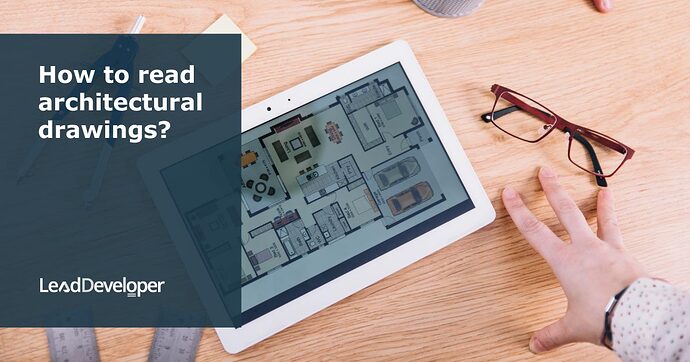Reading Drawings
Learn to interpret architectural and planning drawings. This skill is crucial for making informed decisions in property development and construction. This article discusses various types of drawings one might encounter, including planning and building permit drawings, and offers detailed guidance on how to read them effectively.
Understanding Drawings
Architectural Plans
The speaker begins by stressing the importance of understanding architectural drawings, which are essential for property development. They share their initial challenges in interpreting these plans and aim to simplify the process for beginners.
Types of Drawings
The video differentiates between conceptual drawings used for town planning and working drawings required for building permits. It highlights the purpose of each and how they contribute to the development process.
Key Features in Drawings:
Scale and Detail
Emphasis is placed on scale, drawing numbers, and maintaining a current drawing register to ensure everyone works from the latest plans.
Orientation and Entry
Identifying the orientation, entry points, and layout of the site from the drawings is highlighted as essential for understanding the physical setup of a proposed development.
Practical Tips:
Reading Symbols and Dimensions
You will get practical advice on interpreting various symbols, dimensions, and annotations on the drawings, such as understanding site boundaries, room sizes, and the location of stairs.
Identifying Services
Key utilities and services, such as water meters, hot water systems, and rainwater tanks, are discussed, along with tips on locating them on the drawings.
Maximising Space and Aesthetics:
Space Utilization
The importance of analysing room layouts, sizes, and overall space utilisation to enhance the property’s value and functionality is discussed.
Elevation and Landscape Plans
Learn to read elevation drawings for understanding the exterior look of a building and landscape plans for planning outdoor spaces effectively.
Critical Thinking and Cost Management
Questioning and Adjusting Plans
Viewers are encouraged to assess the plans critically, ask questions about construction materials, and consider potential adjustments to improve aesthetics and functionality.
Cost Estimation
A method for estimating construction costs based on square meterage is shared, along with advice on ensuring the financial viability of a development project.
Insights based on numbers:
- The video discusses the practical use of measurements, such as block and room lengths, and how these impact a building’s design and functionality.
- It also touches on cost estimation per square meter, providing a tangible approach to budgeting for construction projects.
Frequently Asked Questions
How do architectural drawings differentiate between conceptual planning and detailed construction requirements?
Conceptual Drawings
Conceptual drawings are primarily used during the town planning phase. They present an idea or a vision for the property. They are not as detailed as working drawings and convey the general layout, design, and intent of a project. The video emphasises that these drawings are essential for obtaining planning permissions or development approvals, as they outline the proposed use and overall concept of the development.
Working Drawings
In contrast, working drawings are detailed construction plans required to obtain a building permit or approval. These drawings include precise details, measurements, materials, and construction techniques that will be used.
Working drawings are crucial for the construction phase, as they provide contractors and builders with the specifications needed to build the structure as designed. They are comprehensive and include all necessary information for the actual construction, such as electrical layouts, plumbing, structural details, and floor plans.
In what ways can one ensure that the outdoor landscaping enhances rather than obstructs the property’s aesthetics?
Understanding Soft and Hard Surfaces
It begins by distinguishing between ‘soft’ and ‘hard’ surfaces in landscaping plans. Soft surfaces are areas where grass or landscaping that requires upkeep will be placed, while hard surfaces pertain to paved areas, such as concrete or tiles.
The understanding of these surfaces is fundamental to designing a balanced and visually appealing outdoor area.
Placement of Trees and Shrubs
One key point is carefully considering the placement of trees and shrubs. The video advises on ensuring that these elements do not block the views of the property or obscure its windows.
The idea is to position trees and other plantings so that they complement the building’s appearance, contribute to its curb appeal, and maintain the functionality of outdoor spaces.
Considering the Impact on Property Views
It’s crucial to consider how the mature size of trees and shrubs will impact the views from and of the property, suggesting that one should plan for the long-term aesthetics and functionality of landscaping elements.
Integrating Landscaping with Building Design
This approach ensures that the outdoor spaces are not only aesthetically pleasing but also functional and cohesive with the building’s architecture. For example, ensuring that entrances are accessible, outdoor living areas are comfortable, and the property’s overall look is harmonious.
What strategies can maximise space utilisation and functionality in property development?
Detailed Analysis of Room Layouts and Sizes
It emphasises the importance of closely examining the layouts and sizes of rooms depicted in the drawings. By understanding the dimensions and configurations of spaces, developers can identify opportunities to optimise room use, adjust layouts for better flow, or even repurpose areas to increase utility and value.
Assessing Entry Points and Circulation
Understanding how people will move through a space is vital. Analyse entry points, circulation paths, and connections between different building areas to ensure smooth flow and accessibility. This includes considering the placement of stairs, doors, and hallways, as well as the relationship between indoor and outdoor spaces.
Evaluating the Functionality of Service Areas
The location and design of service areas such as kitchens, bathrooms, and utility rooms are scrutinised for efficiency. Consider how these areas integrate with the rest of the property and their accessibility, aiming for designs that support the practical needs of occupants without wasting space.
Critical Review of Architectural Features
Features like staircases, walls, and built-in storage are analysed for their impact on space utilisation. The video encourages a critical review of these features to determine whether they are designed to maximise usable space and contribute to the overall functionality of the property.
Consideration of Outdoor Spaces
Integrating outdoor spaces with the building’s layout is highlighted as a strategy to enhance overall functionality. This includes designing gardens, patios, and balconies to become extensions of the indoor living areas, effectively increasing the usable space of the property.
Future Flexibility
Finally, the video points out the importance of designing spaces that can easily be adapted to future needs. This might involve creating multi-purpose rooms or incorporating flexible design elements that allow for changes in use over time.
Why is it essential to understand architectural drawings?
Understanding architectural drawings is essential for property development as they contain detailed information about the design and specifications of a project. They are crucial for planning, obtaining building permits, and guiding construction work.
What are the main types of drawings in real estate?
1. Site Plan
A site plan is an aerial view drawing of the entire property, showing the building location, boundaries, significant landscape features, and the relationship between the proposed construction and surrounding properties.
It includes details on setbacks, easements, utilities, access roads, and sometimes parking calculations. Site plans are essential for obtaining building permits as they demonstrate how the project fits into its specific site context.
2. Architectural Drawings
Architectural drawings provide a comprehensive view of the building design, including:
- Floor Plans: Show the layout of each building level, detailing room sizes, doors, windows, and the function of each space.
- Elevations: Illustrate the exterior appearance of each side of the building, showing heights, materials, and architectural styling.
- Sections: Cross-sectional views that show how different building components align and interact, including wall construction, roofing details, and insulation.
These drawings are fundamental for permit applications because they detail the aesthetic and functional aspects of the building.
3. Structural Drawings
Structural drawings detail the engineering aspects of the building, including foundations, beams, columns, and other support systems. They specify materials, dimensions, and construction techniques, ensuring the building’s safety and stability. A licensed structural engineer must often stamp these drawings to be accepted with a permit application.
4. Mechanical, Electrical, and Plumbing (MEP) Drawings
MEP drawings are critical for showing how the building will be serviced and comply with local codes for:
- Mechanical Systems: Including HVAC (heating, ventilation, and air conditioning) systems, detailing ductwork, equipment placement, and performance specifications.
- Electrical Systems: Layouts for electrical panels, wiring, outlets, lighting, and other electrical components, ensuring safety and efficiency.
- Plumbing Systems: Water supply and waste lines, fixture locations, and venting systems detailing how water will be distributed and drained from the building.
5. Energy Compliance Drawings
Depending on the jurisdiction, energy compliance drawings or calculations may be required to demonstrate that the building design meets local energy efficiency standards. These can include insulation details, window specifications, and HVAC system efficiency.
6. Landscape Plans
In some cases, detailed landscape plans are required, showing the design of outdoor spaces, including plantings, hardscape elements, lighting, and irrigation systems. These plans ensure the project’s outdoor spaces comply with local landscaping ordinances and contribute to stormwater management solutions.
Why is the scale of a drawing significant?
Scale is vital to interpret the dimensions and layout of a project accurately. It ensures that the design proportions are correctly understood and followed during construction.
How can the orientation and entry points of a site be identified from drawings?
Drawings provide detailed information on the site’s orientation, entry points, and layout, which is essential for understanding the physical setup and planning the development accordingly.
How can critical utilities and services be identified in the drawings?
The speaker discusses locating essential utilities and services like water meters, hot water systems, and rainwater tanks on the drawings, offering tips for effective planning and implementation.
How are elevation and landscape plans useful?
Elevation drawings help understand a building’s exterior look, while landscape plans are essential for effectively planning outdoor spaces, contributing to the development’s aesthetics and functionality.
Why should viewers critically assess the plans?
Viewers are encouraged to critically assess plans, question construction materials, consider potential adjustments to improve aesthetics and functionality and ensure the project meets its objectives.
How do measurements impact the design and functionality of a building?
Measurements, such as the length of blocks and room sizes, play a crucial role in the design and functionality of a building, affecting everything from layout to aesthetic appeal.
What approach does the video suggest for cost estimation?
For cost estimation, the video suggests using practical measurements like cost per square meter to provide a tangible approach to budgeting for construction projects, aiding in financial planning and management.
Test Your Knowledge
1. Why is understanding architectural drawings crucial in property development?
A) To estimate the project cost accurately.
B) For aesthetic purposes only.
C) To make informed decisions about construction and development.
D) To comply with environmental regulations only.
2. What is the main difference between conceptual drawings and working drawings?
A) Conceptual drawings are more detailed.
B) Working drawings are used primarily for aesthetic assessments.
C) Conceptual drawings are for town planning, while working drawings are detailed for building permits.
D) There is no significant difference; they are interchangeable terms.
3. Which feature in drawings helps to ensure everyone works from the latest plans?
A) The color of the drawings
B) The scale
C) Drawing numbers and a current drawing register
D) The size of the paper
4. What is a critical aspect to identify from drawings to understand the physical setup of a proposed development?
A) The designer’s signature
B) The number of pages
C) Orientation and entry points
D) The type of ink used
5. Which of the following is not a practical tip for reading drawings?
A) Memorizing every symbol in the architectural dictionary
B) Interpreting symbols and dimensions
C) Identifying key utilities and services
D) Understanding site boundaries and room sizes
6. How can outdoor landscaping enhance a property’s aesthetics according to the article?
A) By covering the entire property with hard surfaces
B) Through careful placement of trees and shrubs to complement the building’s appearance
C) Ignoring the mature size of trees and shrubs
D) By placing as many decorative elements as possible
7. What strategy is suggested for maximizing space utilization and functionality in property development?
A) Focusing solely on the exterior design
B) Detailed analysis of room layouts and sizes
C) Limiting the number of windows to increase wall space
D) Using only one type of flooring throughout the property to save costs
8. Why are elevation and landscape plans important?
A) They are only necessary for luxury developments.
B) Elevation drawings are useful for understanding the building’s exterior look; landscape plans for planning outdoor spaces.
C) They help in estimating the number of occupants.
D) Only for determining the color scheme of the exterior.
9. How does critically assessing the plans benefit the development project?
A) It ensures that no changes are made to the original design.
B) Allows for questioning and adjusting plans to improve aesthetics and functionality.
C) It is discouraged to maintain project timelines.
D) Only useful for negotiating with contractors.
10. What is the importance of scale in a drawing?
A) It indicates the prestige of the architect.
B) It’s only relevant in large-scale projects.
C) It helps accurately interpret the dimensions and layout of a project.
D) It determines the color palette of the drawing.
Answers:
- C
- C
- C
- C
- A
- B
- B
- B
- B
- C
Assignment
Practical Exercise on Reading Architectural and Planning Drawings
Objective:
To apply the concepts learned from the article on interpreting architectural and planning drawings for property development and construction.
Assignment Overview:
You will be given a set of architectural and planning drawings for a residential development project. Your task is to interpret these drawings to understand the project’s scope, design, functionality, and potential construction costs.
Materials Provided:
- A site plan
- Architectural drawings (including floor plans, elevations, and sections)
- Structural drawings
- MEP (Mechanical, Electrical, and Plumbing) drawings
- Landscape plans
Tasks:
Identify Drawing Types and Their Purpose:
- Differentiate between the provided conceptual drawings and working drawings.
- Describe the purpose of each drawing type in the context of property development.
Interpret Key Features in Drawings:
- Determine the scale used in the architectural drawings and explain its significance.
- Identify the orientation of the building on the site plan and locate the main entry points.
Read Symbols and Dimensions:
- Locate and interpret at least five different symbols used in the architectural drawings.
- Calculate the dimensions of three different rooms using the scale provided.
Locate and Analyze Services:
- Identify the locations of key utilities and services (e.g., water meter, hot water system) on the MEP drawings.
- Discuss how these services’ placement impacts the development’s overall design and functionality.
Maximise Space and Aesthetics:
- Analyse the layout of one-floor plan to suggest improvements for space utilisation and functionality.
- Review the landscape plans and propose changes to enhance the property’s aesthetics without compromising functionality.
Critical Thinking and Cost Management:
- Critically assess the materials specified in the structural drawings. Suggest alternatives that could reduce costs or improve aesthetics.
- Estimate the construction cost per square meter based on the information provided in the drawings and any assumptions you need to make.
Research Questions:
- Investigate the difference between soft and hard landscaping and provide examples of each.
- Research the importance of room layout and size in property development. How does it affect property value and buyer interest?
- Find examples of how modern developments integrate outdoor spaces with indoor living areas.
To Do:
- Prepare a report based on the tasks above, including your findings, interpretations, and suggestions.
- Include sketches or diagrams to illustrate any proposed changes to the layout or landscaping.
- Justify your suggestions with research where applicable.
Submission Guidelines
- Submit your report in PDF format.
- Ensure your report is well-organized, with a clear introduction, body, and conclusion.
- Include references for any external sources or research used.



